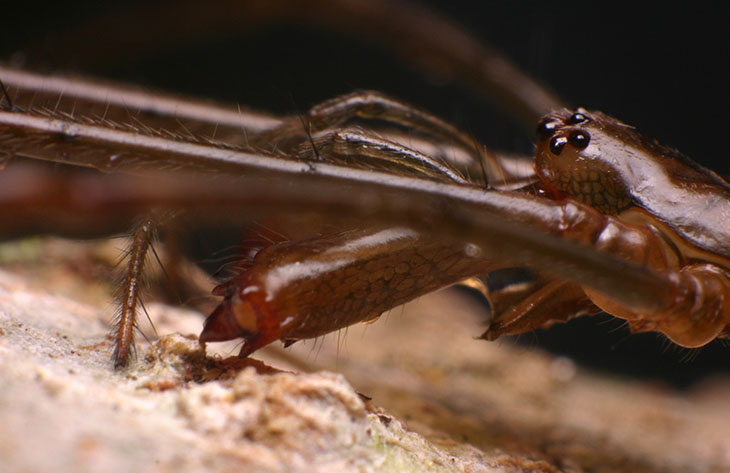
The date of the above shot is unknown; it’s a slide, and I know where it was shot but not when. For some reason this slide has no date stamp, though others, from what I believe was the same trip, do, so I’m going with that: August 2006. Down by a boathouse on Hyco Lake in northern NC, these guys were everywhere, and I took the opportunity to lean in and do a portrait with the Sigma 105mm macro lens, and I’m fairly certain at that time that I had a custom-made macro reflector for the Canon 380EX flash unit, which would normally be pointing over top of such a close subject. This is a long-jawed orb weaver (genus Tetragnatha,) by the way, and I was pleased at the spider facial detail that I captured.
Now we jump forward seven years (or thereabouts) to 2013, seeing the same genus on a trip to Georgia.

This time, instead of slide film in the EOS 3, it was the original Digital Rebel. The Sigma macro had gone wonky and so this was either the Mamiya 80mm macro with extension, or the reversed Sigma 28-105 – I can’t remember which, and obviously neither one was leaving their spoor in the EXIF file. The image up top is full frame, the entire slide, while this is is cropped slightly – call it at least 85% of the full frame, enough that you’d have to look closely to be sure of the change (or at least I did – this image was uploaded back then and I’m just recycling it, but I did compare it to the original file.) The lighting is courtesy of my first decent macro softbox, the Sunpak FP38 with a custom diffuser seen here, which worked great until I inadvertently fried it a couple years later by hooking up an AC adapter set with the wrong voltage (stupid.)
You can see the difference in magnification of course (and the more I look at the latter, the more I’m convinced I’d used the reversed Sigma,) but the lighting deserves a lot of attention too, because it’s responsible for showing so much of the detail, and giving that nice sheen to the chitin without harsh spotlighting. The entire frame may span roughly 12mm or so, and the body width of the spider (not counting legs of course) might top 4mm, likely less. Notably, both were shot ‘in the wild,’ no attempt to restrain the subjects at all, and I was exceptionally lucky with the latter image because spiders tend to be a little shy and go for cover if someone leans in close, but in this case she (yes it’s a female) simply tucked into a line on a trunk and counted on her camouflage, and I managed not to spook her out of sight.
But most of the credit, at least for the advances between the two images, goes to the equipment. To some extent, I knew what I needed but hadn’t dropped the significant money on it, because macro work usually requires lights pointing in very specific locations down directly in front of the lens. To a greater extent, however, I ended up making or modifying what I needed because such things simply don’t exist (yet,) such as the softbox aiming downward at an angle, broad enough to ‘cover’ an entire macro subject so the light doesn’t look directional, but portable enough to carry mounted on the camera. Over the past ten years or so, lots more little fiddly bits like articulated arms became available on the webbertubes, and I could also find obscure variable-output strobes that weren’t ridiculously cumbersome.
And the amazing performance of a defunct mediocre lens, when used backwards, was just an extreme bit of luck that I’m exploiting shamelessly.



















































